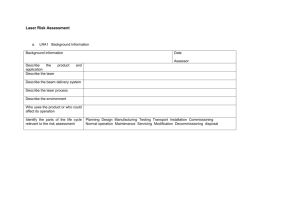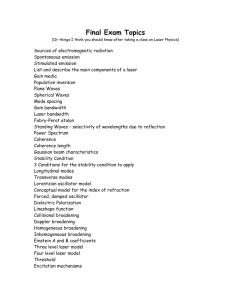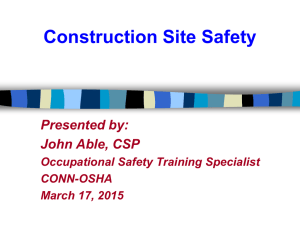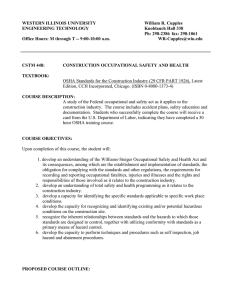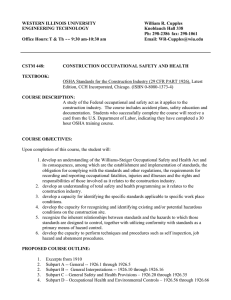1926.955 - Health and Human Services
advertisement
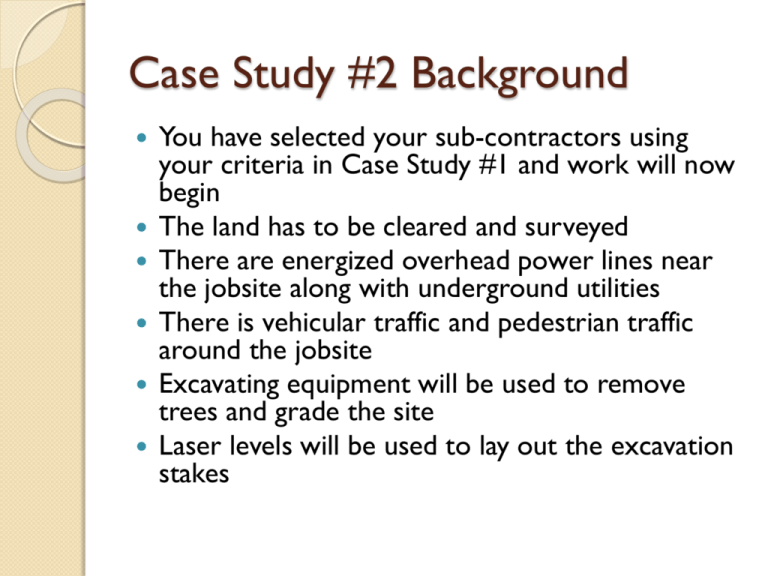
Case Study #2 Background You have selected your sub-contractors using your criteria in Case Study #1 and work will now begin The land has to be cleared and surveyed There are energized overhead power lines near the jobsite along with underground utilities There is vehicular traffic and pedestrian traffic around the jobsite Excavating equipment will be used to remove trees and grade the site Laser levels will be used to lay out the excavation stakes Case Study #2 Using the Pre-planning Report Form, identify two major activities that you would expect to take place during this phase of the construction project. For each activity, identify two major hazards associated with each activity ◦ ◦ ◦ ◦ Describe the hazard Justify the hazard Evaluate the hazard (Cite the OSHA standard) Provide specific controls Hazards due to Contact with Energized Lines Standards designed to protect employees from energized lines appear in a number of sections of the 1926 standards ◦ Subpart K – Employees working around energized lines ◦ Subpart V – Employees engaged in the construction of electric transmission lines and equipment ◦ Subpart L – Scaffolds ◦ Subpart P –Excavations ◦ Subpart CC – Cranes and derricks in Construction 1926.416(a)(1) General Requirements ◦ Protect employees who may be required to work in proximity to any part of an electric power circuit that the employee could contact the electric power circuit in the course of work, unless the employee is protected against electric shock by deenergizing the circuit and grounding it or by guarding it effectively by insulation or other means 1926 Subpart K 1926.400 - .449 Addresses electrical safety requirements that are necessary for the practical safeguarding of employees involved in construction work and is divided into four major divisions and applicable definitions as follows: ◦ Installation safety requirements. Installation safety requirements for electric equipment and installations used to provide electric power and light on jobsites. ◦ Safety-related work practices. Cover hazards arising from the use of electricity at jobsites, these regulations also cover the hazards arising from the accidental contact, direct or indirect, by employees with all energized lines, above or below ground, passing through or near the jobsite. ◦ Safety-related maintenance and environmental considerations. ◦ Safety requirements for special equipment. 1926 Subpart K Applies to the safety requirements for electrical equipment and installations used to provide electric power and light at the jobsite. Applies to installations, both temporary and permanent, used on the jobsite; but these sections do not apply to existing permanent installations that were in place before the construction activity commenced. 1926.416(a)(3) • Before work is begun, the employer has to identify the location of any energized lines. • Post and maintain warning signs • Advise employees of the location of the lines, the hazards involved, and the protective measures to be taken 1926.417 Lockout/Tagout ◦ Equipment or circuits that are deenergized shall be rendered inoperative and shall have tags attached at all points where such equipment or circuits can be energized. 1926.651 When excavating: ◦ The employer is responsible for identifying the estimated location of utility installations, such as sewer, telephone, fuel, electric, water lines, or any other underground installations that reasonably may be expected to be encountered during excavation work, shall be determined prior to opening an excavation. ◦ Utility companies or owners shall be contacted within established or customary local response times, advised of the proposed work, and asked to establish the location of the utility underground installations prior to the start of actual excavation. 1926.651 ◦ When utility companies or owners cannot respond to a request to locate underground utility installations within 24 hours (unless a longer period is required by state or local law*), or cannot establish the exact location of these installations, the employer may proceed, provided the employer does so with caution, and provided detection equipment or other acceptable means to locate utility installations are used. *Note: Most states require 48 hours notice Underground Utility Locating Service Varies from state to state and could vary from county to county within a state Determine what agency to contact Utilities may include: ◦ ◦ ◦ ◦ ◦ Electric Cable TV Water Natural Gas Fiber Optics Marking System APWA – American Public Works Association ◦ Color coded system for marking utilities Fines and Penalties In addition to OSHA violations, states and the federal government can impose fines. States have Underground Damage Prevention Act’s in place ◦ Example: In Illinois, $5,000 for each separate offense and shall be liable for the damage caused to the owners or operators of the facility. ◦ If willfully fails to comply, subject to additional penalties of up to $2,500 per offense Outside Open Conductors On a construction site, it is possible that energized overhead power lines may be near the construction site. Open Conductor – A single conductor not enclosed in a raceway or cable sheath 29 CFR 1926.404(c) ◦ Open conductors shall conform to the following minimum clearances: 10 feet (3.05 m)-above finished grade, sidewalks, or from any platform or projection from which they might be reached. 12 feet (3.66 m)-over areas subject to vehicular traffic other than truck traffic. 15 feet (4.57 m)-over areas other than those specified in paragraph (c)(1)(ii)(D) of this section that are subject to truck traffic. 18 feet (5.49 m)-over public streets, alleys, roads, and driveways. 1926.604 Site Clearing Employees engaged in site clearing shall be protected from hazards of irritant and toxic plants and instructed in the first aid treatment available. All equipment used in site clearing operations shall be equipped with rollover guards meeting OSHA requirements. Rider-operated equipment shall be equipped with an overhead and rear canopy guard meeting OSHA requirements. Laser Safety Laser hazards associated with surveying, may fall under 1926 Subpart D, Occupational health and environmental controls ◦ 1926.54 – Non-ionizing radiation 1926 Subpart E, Personal protective and life saving equipment addresses PPE requirements ◦ 1926.102, Eye and face protection 1926.102(b)(2), Laser protection Classes of Lasers Class 1- incapable of producing damaging radiation during operations and use. ◦ Users of Class 1 lasers are generally exempt from radiation hazard controls during operation and maintenance, but not necessarily during service. Most Class 1 industrial lasers consist of a higher class laser enclosed in a properly interlocked and labeled protective enclosure. Class 2-(low power) 2 and 2a, 400nm to 700 NM range (Example: a supermarket laser scanner.) Classes of Lasers Class 3- (medium power) 3A and 3Bb, hazardous under direct and reflective viewing conditions. 1 milliwatt to 55 milliwatt range. Not a fire hazard. Class 4- (high power) pose hazards to eyes and skin due to direct beam and from diffused reflection in some cases. Can be a fire hazard, produces air contaminants and plasma radiation. Power above 500 milliwatt. Only qualified trained employees are to operate the lasers.(Excimer laser operating in the ultraviolet) Construction Industry Standards and Laser Classes The Construction Industry standard does not recognize different classes of lasers. All of the provisions of the standard technically apply to all uses of lasers in the construction industry. However, Class I lasers are determined to present no hazard. ◦ For example: Some construction laser levels can be a Class I laser Violations of the 1926 standards which should really only apply to higher class lasers should, in the case of Class I lasers, be regarded as "de minimus," which means there would be no citation, no penalty, and no compliance date. Laser Training The employer shall provide for the instruction of each laser equipment operator and instructor in accordance with the applicable manufacturer's recommendations. The instruction process shall inform the operator of various hazards associated with the use of the equipment and the necessary or recommended control measures for the elimination of hazards to personnel. Laser Training In addition to information from the manufacturer, the American National Standard ANSI Z136.1-1986 could be reviewed for training information. Instruction should be conducted by a qualified representative of the manufacturer, or by a knowledgeable individual designated by the employer.




